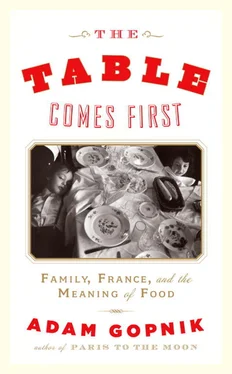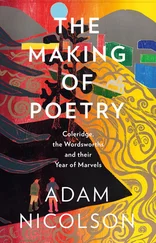Stéphane Jégo, the chef at L’Ami Jean, had a black eye that day—the prize of a rugby fight—but his food was wonderful, varied and intelligent, and full of southwestern folk charm: slow-cooked veal shin, tender without being mushy and comforting without being dull; the usual foie gras, but here more buttery than bland; and the best rice-pudding dessert I have ever had, complete with black-cherry confit. I hadn’t had a better meal in Paris in a long time. But was it a new frontier? Could you build a revolution on rice pudding, even great rice pudding? “We need to change, we need to move,” Marine said, but the movement seemed to be movement within the same familiar thing.
Change we can eat… The Western world has been filled with food-reform movements in the past twenty years. Slow food, the Edible Schoolyard, the various vegetarian and ethical movements sprung by the likes of Peter Singer—in no other time would a highly regarded young novelist like Jonathan Safran Foer view a book about the anti–animal eating movement as a necessary extension of his oeuvre, the way a novelist in the sixties might have felt obliged to write a book about the antiwar movement. This proves, depending on your point of view, either that the reform of food has become essential to the reform of life or that, failing in the reform of life, we reform our food instead. Yet all these movements—vegan and whole beast, localist and seasonalist—share a sense that the industrialized, Americanized food economy is destructive of small-scale, European, traditional, farm-based eating.
What distinguishes Le Fooding, I was beginning to understand, was that it is, in effect, against an overly European, tradition-minded approach to food. Slow is the last thing it wants French cooking to be, French cooking being slow enough already. The goal of the Fooding movement is to break down French snobbery, in the form of its hidebound, hypersensitive discrimination, while the goal of the slow-food movement, though not put quite this way, is to build up American hidebound hyperdiscrimination. Fooding is a form of culinary futurism: it wants the table to move as fast as modern life. (And, indeed, the Italian futurists were obsessed with food, and wrote their own cookbook.) The Fooding guide is open to pizzerias; Alexandre says that it is even open to fast food, in the right time and the right place. Although McDonald’s and the like are not included in the guide, Alexandre has admitted to a certain affection for the Chipotle Mexican Grill, and can recall a welcome meal at a McDonald’s in the Carpathian Mountains.
When I pressed Alexandre about the difference between the nouvelle-cuisine revolution in the seventies and the Fooding revolution, he had no difficulty defining it. “Nouvelle cuisine manifested itself in terms of rules,” he said. “Its practitioners rejected the old rules but had rules of their own: instead of too much butter, no butter at all. They replaced the norms with other norms. We’re for liberty, for the end of categories—a good meal is a rich experience, of any sort. They said no butter. We say no rules! No rules save excellence.” He looked grave. “And another thing. Nouvelle cuisine was largely cut off from the changes in the society going on around it. It was a palace revolution. We want a cuisine of this time that is in harmony with this time. The philosophy of food in France has always bent toward the right, sometimes the extreme right—Christian Millau and Henri Gault both came from right-wing backgrounds. I find that the posture of Le Fooding can be replayed in politics, but in a different key. Not Sarkozy, but Cohn-Bendit. A new openness. An end to false boundaries between peoples, as between brasseries, bistros, grand restaurants, and the like. All that matters is talent.”
In America and England, you are what you think about eating. Tell me where you stand on Michelle Obama’s organic White House garden and (with the exception of a handful of “Crunchy Cons” and another handful of grumpy left-wing nostalgists for whiskey and cigarettes) I can tell what the rest of your politics are. People who are in favor of a new approach to food—even if that approach involves a return to heritage breeds and discarded farming methods—are in favor of a new approach to social life. But in France the philosophy of food does not break on such neat party lines. In France, the diehards for the traditional national cuisine tend to write for leftish magazines and newspapers, like Marianne and Libération , while those most open to innovation from the exotic tend to be found in the pages of the center-right Le Point and Le Figaro . An organic garden at the Elysée Palace might be a sign of surging nationalism, or of pluralist internationalism… it would be hard to know which in advance. Alexandre, who says that he now regrets his vote for the centrist François Bayrou in the last presidential election, cannot, as a rule, count on a reliable base of supporters, which may be why Le Fooding constantly needs to whip up new enthusiasts at its events. The politics of food in France cut haphazardly and unpredictably across party lines and allegiances; tell me what you think about eating, and I will tell you only that you are French.
And yet there was enough intuitive enthusiasm to bring a handful of those new-old French cooks to P.S. 1, for Le Fooding d’Amour. Organized by a new executive at Le Fooding named Anna Polonsky, a young Anouk Aimée as rendered by Modigliani, it had induced Yves Camdeborde and Stéphane Jégo, the twin princes of the French movement, to make the trip, and several fashionable New York cooks—among them Lee Hanson, of Minetta Tavern, and David Chang, of Momofuku—came, too. There was a belly dancer, and wandering musicians, and long lines at the food tables; Stéphane Jégo’s slow-cooked lamb, braised for twenty-four hours, was, like his Paris veal shin, particularly memorable, as, in another way, were the mini burgers from Minetta.
I sought out Yves Camdeborde, and he spoke intently about his commitment to Fooding as a movement. “If we don’t do this, we’re against the wall,” he began. “The Michelin Guide approach is dead. I worked at the grandes maisons , at the Crillon. They look at the rug, and they measure the chandeliers. We’ll go right into a wall if we continue this way. What can it mean? Two stars? Three stars? Who cares?” His tone was not angry, or indignant. He simply looked over at the tables of the American chefs, passing out mini burgers as lines grew ever longer. “It’s more than a bistro movement. People say, Bistro, bistro, bistro. But what I do is not bistro—it’s aubergiste .” He looked at me keenly, to make sure I followed the distinction: an auberge is a rural inn. “I’m a kind of urban aubergiste . It’s a cuisine of complexity and high quality—high cooking without pretension. Slow food—slow food is about defending the traditions, the terroirs , the quality of products. It’s about producers. This movement is about consumers: about remaking the clientele. It’s a way of increasing the spontaneity of things.”
As Camdeborde said that, I suddenly saw the right analogy: Le Fooding was to cooking what the New Wave was to French cinema. The hidden goal was to Americanize French food without becoming American, just as the New Wave, back in the fifties and sixties, was about taking in Hollywood virtues without being Hollywoodized—taking in some of the energy and optimism and informality that the French still associate with American movies while reimagining them as something distinctly French. It had a similar cast of characters, with Cammas as André Bazin, the propagandist; Rubin as the anathematized Eric Rohmer; Jégo as Truffaut, the humanist-revolutionary; and Camdeborde as Godard, the serious radical. Like the New Wave filmmakers, these chefs had a vague sense of what they wanted, combined with a vigorous determination to achieve it, whatever the hell it was. Both were movements to remake French audiences in the light of American attitudes—to refashion their expectations as much as to create a new kind of object. The idea was that we had to change taste in order to change art. Appreciating old movies in a new way was as much a part of the legacy of the New Wave as making new ones. Eating with a new attitude was as important to Le Fooding as actually eating something new. The creative act in cooking was to change the style of criticism.
Читать дальше












